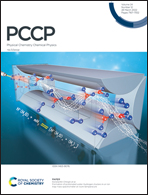High-performance, self-powered flexible MoS2 photodetectors with asymmetric van der Waals gaps†
Abstract
With an urgent demand for low-energy-consumption and wearable devices, it is desirable to find an easy, effective, and low-cost method to fabricate self-powered flexible photodetectors with simple configurations and high-performance. Self-powered photodetectors are normally fabricated based on either two different materials or the same material in contact with two different metal electrodes. Here, a flexible MoS2 photodetector with the same Au electrodes was fabricated on a polyethylene terephthalate (PET) substrate which exhibits self-powered properties. To our knowledge, its configuration is the simplest, and the fabrication process is easy to implement. At a bias of 0 V, the photodetector exhibits a high responsivity of 431 mA W−1, a short response/recovery time of 40 ms/40 ms, and excellent flexibility. Compared with those at a bias of 2 V, a dark current is sufficiently suppressed, and the response/recovery speed is significantly improved. It is found that the driving force of the self-powered photodetector is provided by the asymmetric Schottky barriers originating from the spontaneous generation of two van der Waals gaps with different widths. The asymmetric barriers exist stably at the interfaces between the 2D material and Au electrodes as further observed for ReS2 or GaSe flakes, which show the generality of asymmetric Schottky barriers between the 2D material and Au electrodes. The discovery here thus gives a new way to generate asymmetric Schottky barriers and develop high-performance self-powered photodetectors.



 Please wait while we load your content...
Please wait while we load your content...